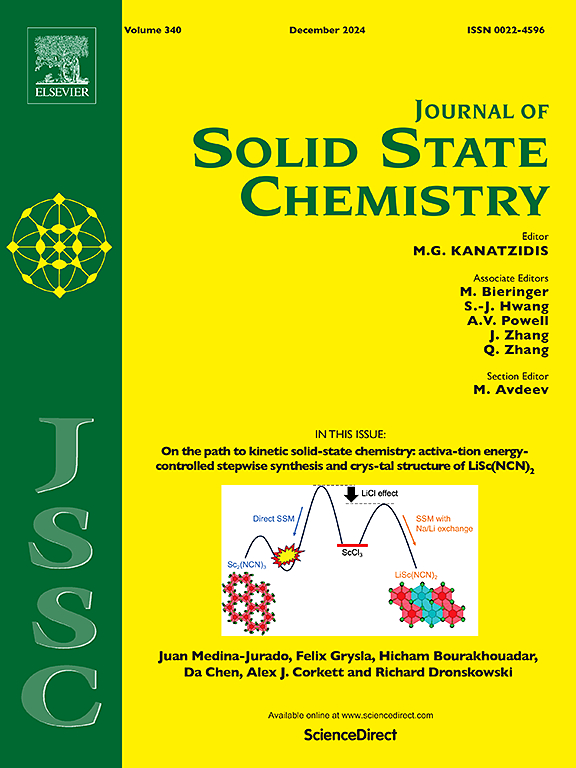Adsorption of sodium diclofenac on vinylbenzyl trimethylammonium chloride-modified covalent organic polymer
IF 3.2
3区 化学
Q2 CHEMISTRY, INORGANIC & NUCLEAR
引用次数: 0
Abstract
The effective removal of diclofenac sodium (DCF) has become an important topic in waste management because of its poor efficiency in wastewater treatment. In this study, covalent organic polymer (COPs) were modified with vinylbenzyl trimethylammonium chloride (VTC), an organic compound containing abundant aromatic rings and quaternary ammonium groups. The structure of the resulting adsorbent (VTC-COPs) was investigated via FTIR, XRD, TGA, SEM, BET, and XPS. The modified VTC-COPs exhibited a mesopore structure with a pore size of 27.9 nm and a specific surface area of 38.5 m2/g. The DCF removal performance of VTC-COPs in aqueous solutions was evaluated by a batch adsorption experiment. At pH 6, the saturated adsorption capacity of VTC-COPs reached 458 mg/g, whereas that of the original C![]() C-COPs was 346 mg/g. The results show that the Langmuir adsorption isotherm and pseudo-second-order kinetic models can effectively describe the equilibrium adsorption process. According to the Langmuir model, the maximum adsorption capacity of the adsorbent VTC-COPs at 298 K was 616 mg/g. The negative ΔH and ΔG values obtained through thermodynamic parameters confirmed that the DCF adsorption of VTC-COPs was a spontaneous exothermic process. Coexisting ions influenced adsorption in the following order: PO43− > SO42− > CO32− > NO3− > Cl−. The desorption experiment shows that DCF desorption can recover the material in a 0.1 mol/L NaOH solution. After 10 sorption-desorption cycles, the performance loss of VTC-COPs was only 5 %. The post-adsorption FTIR, BET, SEM, and XPS analysis results show that the nitrogen functional groups and aromatic rings of VTC-COPs interact with DCF. The adsorption mechanism is primarily based on electrostatic interaction, π–π interaction, and pore filling. According to these results, VTC-COPs can be considered a viable adsorbent for removing DCF from wastewater.
C-COPs was 346 mg/g. The results show that the Langmuir adsorption isotherm and pseudo-second-order kinetic models can effectively describe the equilibrium adsorption process. According to the Langmuir model, the maximum adsorption capacity of the adsorbent VTC-COPs at 298 K was 616 mg/g. The negative ΔH and ΔG values obtained through thermodynamic parameters confirmed that the DCF adsorption of VTC-COPs was a spontaneous exothermic process. Coexisting ions influenced adsorption in the following order: PO43− > SO42− > CO32− > NO3− > Cl−. The desorption experiment shows that DCF desorption can recover the material in a 0.1 mol/L NaOH solution. After 10 sorption-desorption cycles, the performance loss of VTC-COPs was only 5 %. The post-adsorption FTIR, BET, SEM, and XPS analysis results show that the nitrogen functional groups and aromatic rings of VTC-COPs interact with DCF. The adsorption mechanism is primarily based on electrostatic interaction, π–π interaction, and pore filling. According to these results, VTC-COPs can be considered a viable adsorbent for removing DCF from wastewater.
乙烯苄基三甲氯化铵改性共价有机聚合物对双氯芬酸钠的吸附研究
双氯芬酸钠(DCF)在废水处理中效率不高,如何有效去除它已成为废物管理领域的一个重要课题。本研究以含有丰富芳环和季铵基团的有机化合物乙烯苄基三甲基氯化铵(VTC)对共价有机聚合物(COPs)进行了改性。通过FTIR、XRD、TGA、SEM、BET和XPS等手段对所得吸附剂(VTC-COPs)的结构进行了表征。改性后的VTC-COPs具有中孔结构,孔径为27.9 nm,比表面积为38.5 m2/g。通过批量吸附实验,评价了VTC-COPs在水溶液中对DCF的去除性能。pH值为6时,VTC-COPs的饱和吸附量为458 mg/g,而原CC-COPs的饱和吸附量为346 mg/g。结果表明,Langmuir吸附等温线和拟二级动力学模型能有效地描述吸附平衡过程。根据Langmuir模型,吸附剂VTC-COPs在298 K下的最大吸附量为616 mg/g。热力学参数得到的负ΔH和ΔG值证实了VTC-COPs对DCF的吸附是一个自发放热过程。共存离子对吸附的影响顺序如下:PO43−>;SO42−祝辞CO32−祝辞3号−祝辞Cl−。解吸实验表明,DCF解吸可以在0.1 mol/L NaOH溶液中回收材料。经过10次吸附-解吸循环后,vtc - cop的性能损失仅为5%。吸附后的FTIR、BET、SEM和XPS分析结果表明,VTC-COPs的氮官能团和芳香环与DCF相互作用。吸附机理主要基于静电相互作用、π -π相互作用和孔隙填充。综上所述,VTC-COPs可被认为是一种可行的去除废水中DCF的吸附剂。
本文章由计算机程序翻译,如有差异,请以英文原文为准。
求助全文
约1分钟内获得全文
求助全文
来源期刊

Journal of Solid State Chemistry
化学-无机化学与核化学
CiteScore
6.00
自引率
9.10%
发文量
848
审稿时长
25 days
期刊介绍:
Covering major developments in the field of solid state chemistry and related areas such as ceramics and amorphous materials, the Journal of Solid State Chemistry features studies of chemical, structural, thermodynamic, electronic, magnetic, and optical properties and processes in solids.
 求助内容:
求助内容: 应助结果提醒方式:
应助结果提醒方式:


